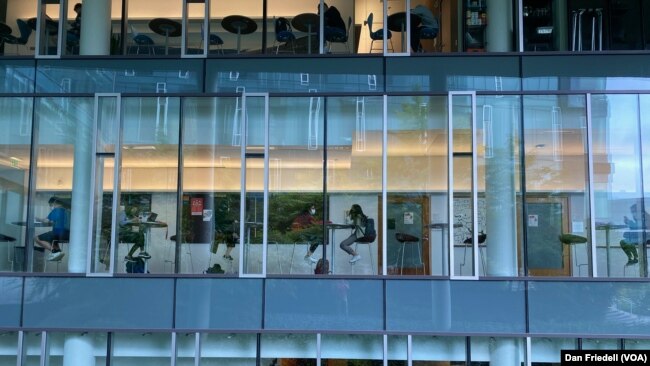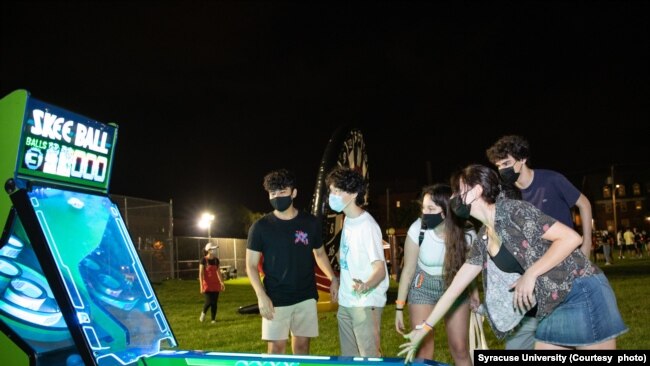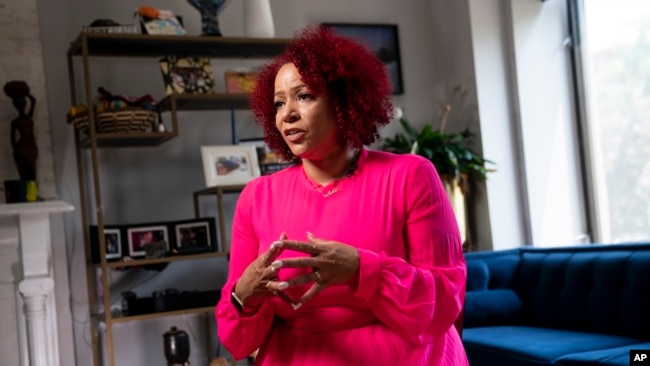As 2021 started, many American university students were still taking classes by video link because of restrictions related to the COVID-19 pandemic.
But the availability of vaccines meant that students at most of the nation’s colleges were back by the start of the 2021-2022 school year.
Sue Lorenson, the Vice Dean for Undergraduate Education in the College of Arts and Sciences at Georgetown University, said the goal at her school was to get students “as many in-person experiences as possible.”
Back to the Robotics Lab
And for the first part of the school year, most schools were back to normal. For example, at Carnegie Mellon University in Pittsburgh, Pennsylvania, students got back to work in the school’s robotics lab.
It was a welcome change for Professor Zac Manchester, who remembered the first part of 2021 as a time where he worked with a student by video call so he could build small satellites for use on a SpaceX rocket launch.

By September 2021, Manchester and his students at Carnegie Mellon were working in person. Their main goal? Test the guesses they made in computer code for their robots. He called it the “sim-to-real gap.” Sim is short for simulation.
He added, “there’s always little extra ‘gotchas’ when you try to do something in the real world.” The plan was to fix the problems by testing in the laboratory instead of on computers.
Bart Duisterhof is a student working on an additional degree. He came from The Netherlands. He said if scientists create things that only work in the laboratory, they might have a problem in the future.
The “Other Freshman Class”
Other students got the chance to go to campus for the first time in the autumn of 2021, even though they already completed one year of college. Those students became known as “the other freshman class.”
One of those students was Jheannelle Johnson from Florida. She arrived in Washington, D.C. to study at Howard University. Howard is one of the most famous Historically Black Colleges and Universities in the U.S. They are known as HBCUs. Many famous people, including U.S. Vice President Kamala Harris, attended Howard.
Johnson had the chance to meet schoolmates she had only seen on video or spoken with on the phone. She went to campus events like the homecoming pep rally.

But she was worried about taking tests after working from home for one year. She also got to see a student protest at the Howard campus for a number of weeks.
Mallika Gore is from India. She is a second-year student at Syracuse University in New York state. Gore said it was good to get a chance to meet professors in person and ask questions this year.
The excitement of the in-person learning faded as 2021 came to a close, however. A few universities in the U.S. sent students home for winter break early. It is unclear whether students will be back taking classes in-person to start 2022 because of restrictions related to the Omicron version of the new coronavirus.
VOA spoke with Gore, the student from India again. She said she was worried about the next part of the school year when she returns to New York from India.
“For me, it’s the worry that if I come, what will be changed? I hope I don’t have to, mid-semester, go back to my country. So, I think that’s the worry.”
Howard University, Other HBCUs Gain Notice
However, the year in higher education was not only centered on the COVID-19 pandemic. There were other notable news stories.
For example, Howard University and other HBCUs received increased attention, especially after Kamala Harris was sworn in as Vice President.
At about the same time, Raphael Warnock from Georgia became a U.S. Senator. Warnock went to Morehouse College in Atlanta. In 2020, MacKenzie Scott, the former wife of Amazon’s Jeff Bezos, donated about $4 billion to educational organizations. That included many HBCUs.
But along with the money, Black students at HBCUs told VOA that they are more at ease attending classes at schools where they are not minorities.
Jabari Johnson is a student from Maryland. He attends North Carolina A&T. He said he feels “at home” there.
“Going around, seeing people who have the same background as me, and seeing people like me that want to do well in their life and want to strive for greatness at this school, really makes me feel at home.”

In addition, two of the nation’s top Black writers decided to join Howard. Nikole Hannah-Jones, a writer for the New York Times, decided to say no to a job at the University of North Carolina, Chapel Hill. She won a Pulitzer Prize for creating The 1619 Project for the New York Times magazine.
Ta-Nehisi Coates, a well-known writer whose 2015 book Between the World and Me won a National Book Award, is also joining Howard.
A New TOEFL From ETS
For students outside of the U.S., there was an important new development in the way they can prove their English ability. The American organization ETS released TOEFL Essentials. It is a shorter and less-costly version of the organization’s traditional English language test. Some schools are now using this test for international students.
Srikant Gopal of ETS called the new test “innovative” because of the way it bases the difficulty of its questions on how a student has answered earlier questions. That is what an “adaptive” test does. However, one expert said the move by ETS is a reaction to the growing popularity of the Duolingo English Test. Duolingo is a company that makes online language teaching tools.
Gabriel Guillen of the Middlebury Institute of International Studies said the new TOEFL is “good news,” but it is also “pretty obvious that they are responding to the competition of Duolingo.”
College Athletes Earn Money, Give it Away
Finally, how is this for some good news to end the year? College athletes in the U.S. for years were not permitted to make money from their fame. Athletes scored points in football games at large universities like Ohio State and Alabama in front of thousands of fans, but could not use their name or picture to make money. In fact, they were punished if they took money, cars or free food from others because of college rules.
However, that changed in 2021.
Some students did gain some money in 2021. However, some students gave away money.
In recent weeks there were stories about football players from the Ohio State University, the University of Nebraska and the University of Iowa who each gave many thousands of dollars they earned this year to charities.
Tyler Linderbaum from Iowa gave $30,000 to a children’s hospital.
I’m Dan Friedell.
Dan Friedell wrote this story for Learning English based on stories from earlier in 2021. Mario Ritter, Jr. was the editor.
What were the most important higher education stories for you in 2021? What are you excited about for 2022? Tell us in the Comments Section and visit WWW.VOA-STORY.COM
Quiz – Students Return to Campus, HBCU Gains, New TOEFL and More…
Start the Quiz to find out
_________________________________________________
Words in This Story
code –n. a set of instructions for a computer
simulation – n. something that is made to look, feel, or behave like something else especially so that it can be studied or used to train people
gotcha – n. an unexpected problem or usually unpleasant surprise
campus –n. the area and buildings around a university, college, school or similar organization
pep rally – n. an event before a school sports event that is meant to get students and fans excited and to encourage the team to win
semester – n. one of two usually 18-week periods that make up an academic year at a school or college
background – n. the experiences, knowledge, education, etc., in a person’s past
strive – v. to try very hard to do or achieve something
innovative –adj. introducing or using new ideas or methods
obvious – adj. easy to see or notice
charity – n. an organization that helps people who are poor, sick